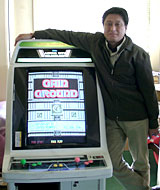 The following interview was originally published in 2003 as part of Sega of Japan’s Masterpiece Album series, which featured comprehensive talks with some of Sega’s brightest Japanese arcade and console designers. It was translated by the author as research material for the Gain Ground section of the book The Sega Arcade Revolution: A History in 62 Games.
The following interview was originally published in 2003 as part of Sega of Japan’s Masterpiece Album series, which featured comprehensive talks with some of Sega’s brightest Japanese arcade and console designers. It was translated by the author as research material for the Gain Ground section of the book The Sega Arcade Revolution: A History in 62 Games.
Yoshiki Ooka joined Sega in 1985. As a programmer, he worked on many titles, including the arcade hits Quartet, Heavyweight Champ, Gain Ground, and Shadow Dancer. Afterwards, he worked as a director on titles such as YuYu Hakusho Gaiden and Doraemon 7 Nin no Gozans. Following these efforts, Ooka provided support to third party developers working on titles for the Saturn, 32X, and Dreamcast. He left Sega in 2003.
Sega: Even today some arcades still have Gain Ground machines.
Yoshiki Ooka: There’s one in Shinjuku Sports Land #3, on the second floor in front of the vending machines. Whenever I’m there, someone is playing. I think it’s been that way for five years, that’s why it hasn’t been phased out. I want to know how much this machine makes! (laughs)
Sega: It’s been 15 years since the release… it really had a long run.
Yoshiki Ooka: With Gain Ground you don’t get the appeal just by looking at the instruction card, so in the beginning the proceeds weren’t considerable. We made a game that turned off first time players (bitter laugh) because the game only really picks up after round one, in the middle of round two (one round is comprised of 10 stages).
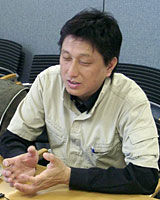
Yoshiki Ooka: The game starts to shine from round three and onward, after you’ve cleared about 20 screens (laughs). It was a while after the release I think, but once Mr. Koji Kendou of Maikon BASIC Magazine wrote about the game, I think people started to appreciate it. Without people like him, who pointed out how deep the game is, I think Gain Ground wouldn’t be as appreciated as it is now. [Ed. Note: Kendou was a famous writer for the magazine, in charge of arcade walkthroughs and the reader’s corner. He’s now CEO at Noise Games.]
Sega: How did you start when designing Gain Ground?
Yoshiki Ooka: From a business perspective, Sega wanted a fun multiplayer game like Gauntlet for the American market, so people would just pump in quarters (laughs). Because of that, when we started going through designs for Gain Ground, I kept Gauntlet at the front of my mind, so much so that I gave the team a copy and said to use it as a reference (laughs). But once we started actually making it, the game’s nature soon changed, and we changed the elements.
Sega: Did it resemble Gauntlet at the beginning?
Yoshiki Ooka: No. In the beginning, one player could pick from three characters (in Gauntlet, each player had one character assigned to him) and the nature of the game was also very different. Gauntlet was about physical combat, and Gain Ground was about shooting. By the way, in the initial designs collecting money was more important than fighting enemies. You were able to buy and sell players at a place called “Mercenary Corner” (laughs). While building that, the system matured.
Sega: That system wasn’t used, right?
Yoshiki Ooka: Right. We took the shop system from the arcade game Fantasy Zone (where you buy weapons and characters with coins you collect), but in Gain Ground it would have been out of place. If you could buy characters, it would have been tough to balance the difficulty and make the game arcade-like. So, we scrapped the Mercenary idea and went with the current system (you get characters on your way).
Sega: You changed the system during development?
Yoshiki Ooka: Right. For example, the fact that a character becomes a captive upon taking damage wasn’t in the original plan, but we had trouble balancing the difficulty when you lost characters important to the scenario, so we put it in. The player-swapping system came about at the same time.
Sega: At the time, in 1988, I think it was rare for an arcade game to only have non-scrolling single screens. Was that also something you decided on during that design stage?
Yoshiki Ooka: Originally, we wanted to implement scrolling but scrolling games are hard to play in multiplayer. For example when one player is in the back doing his best, but the others move forward and force the screen to scroll. There are games that implement that, but in the end not all players can move freely. This game is more tactical; you have to plan ahead when to kill which enemy, and you have to form a strategy and follow it. When we started programming, we had endless arguments until we just put in the fixed screens. By the way, the top-down perspective was planned from the beginning.
Sega: The character actions are also very detailed. When you throw a spear it flies in an arc, characters have a dominant arm…Was that also planned from the beginning?
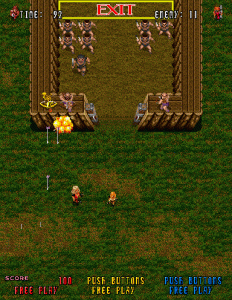
Yoshiki Ooka: Many of the staff where were fussy with details, and I think that had a big influence on the game. It wasn’t planned from the beginning but when we started doing things for real, a designer would complain “the throwing animation and the item don’t line up,” and then we’d fix up the graphics. Spears flying in an arc was programmed like that from the beginning because of the top-down perspective. Sega’s System 24 board was able to scale up sprites, so we just exaggerated, that and it really stood out.
Sega: What part of the programming were you in charge of?
Yoshiki Ooka: I did the programming for all the regular enemies and the test mode. The test players probably didn’t notice, but I was diligently graphing their play history ( laughs). The player character, bosses and main systems were programmed by someone above me. The game’s framework was very tight, so I could focus on the enemy AI. Although honestly, programming the characters was a series of trial and error.
Sega: Did you have a favorite character while programming?
Yoshiki Ooka: “Graphically,” I don’t remember much, to be honest. Personally I mainly recall the enemy AI routines and the beauty of the programming. Of course we got the character data from the designers and then assembled the animations frame by frame. But we thought it would be easier to convey nice character movement instead of pretty animations, so we’d change flags bit by bit, seeing what should move how and when… it was like assembling a mechanical toy, and sometimes I’d have to deal with movements I didn’t even understand (laughs). I mainly remember how fun it was to create such a divergent program and to layout the parameters.
Sega: Did it take a lot of time to program the enemies?
Yoshiki Ooka: Yes. It took a lot of trial and error to find out how to write a general AI routine that could be adjusted for different situations. For example, if there is an obstacle, the enemy has to approach the player while avoiding it. If two enemies are attacking the same player character, you have to figure out how to avoid a pile-up… I had to do these things many many many times. It took me one year and three months to finish it. Today that would be inexcusable, but since this was my first programming job, the others were quite generous (laughs).
Sega: Compared to other games of the time that’s quite long (laughs).
Yoshiki Ooka: In the first nine months we only managed to finish two rounds. I myself was thinking too much and wasn’t able to make any progress. On the side, Altered Beast had been finished and the Alien Storm team lead got suspicious… so I had to leave some stuff out, because we didn’t have any time (laughs). Originally, in addition to the ancient, early modern, middle age and future era, there was supposed to be a “present day” era (which was included in the Mega Drive version; so content-wise, that version could be considered the “true” version).
In the beginning we planned to have 50-60 screens in the arcade version, but because I was working too slowly we had to omit the present day level. The designers only had three stages of the present day era ready and the enemies weren’t set up yet, so we just got the order to scrap it and leave the game with 40 stages (laughs). After we got the order we got desperate. I think we finished the entirety of stage four, the future stage, over the course of three days and three nights straight. There also weren’t many enemies with complex animations.
Sega: Could it be that programming in this state led to bugs like the one in 4-8? (laughs).
Yoshiki Ooka: We had actually fixed and saved that one, but when the deadline came we forgot to link it (laughs). The entire team was so stressed; we just overlooked it… But it’s at times like this when the “Spirit of Games” enters your body and you keep working even though your mind isn’t really there. So, maybe we just imagined having fixed that bug… This is off-subject, but when you pull all-nighters, you start seeing things after the second day… caterpillar-like things, like ectoplasm, crawling between your fingers and around your body.
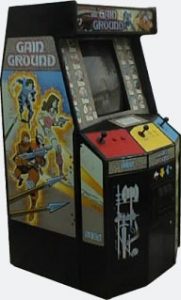
Sega: Let’s leave the caterpillars alone for now (laughs). Is there a version where the 4-8 bug is fixed?
Yoshiki Ooka: We hastily fixed the bug and released a three-player version. Since we didn’t see any impact on sales, we left the bugged versions as they were and only fixed the bug in future two-player machines.
Sega: It’s said that the presence of the 4-8 bug led to a dramatic development among the development team. [Ed. Note: In Gain Ground you can clear a stage by either destroying all the enemies or reaching the exit with all your characters. In level 4-8, there are enemy laser turrets the player has to destroy but due to the bug they don’t actually tick down the enemy counter, meaning you can’t finish this stage by killing all the enemies. To get all your characters to the exit, you have to sacrifice some as human shields to get your important characters past the turrets. What’s even more interesting is that many Japanese players originally thought this was intentional, as they felt it fit the game’s story and world. It’s become so accepted that future ports (like the Sega AGES version) made the bugfix optional.]
Yoshiki Ooka: Honestly, it was just an accident. We didn’t expect anyone to beat the last boss with Zaemon (laughs)… We thought everyone would be having a hard time. But when we heard that players were knocking out the boss with a single tornado attack we immediately tried it out and went “oh wow, it actually works!” I really think that when you allow a certain degree of freedom, new rules will emerge on their own.
Sega: Do you think this is part of the charm of Gain Ground?
Yoshiki Ooka: There are countless ways for players to defeat enemies and even the slightest change in timing or movement can affect the enemy’s behavior. I think this unpredictable depth is Gain Ground’s major appeal. In this sense I feel like I was able to create what I had envisioned.
Sega: We’ve already touched upon this, but the two-player cabinet of Gain Ground is very popular, but I’ve heard that there is a three-player cabinet as well…
Yoshiki Ooka: We started developing a three-player cabinet version of Gain Ground for the overseas market. We used the Quartet cabinet, which was reused for a lot of other three-player games, but when we considered the business side and the Japanese arcades, we eventually ended up producing a two-player version. The three-player cabinet was never released, but there were conversion kits for Quartet, so I think at least a few people in Japan have played the three-player version.
Sega: How does the three-player version differ from the two-player one?
Yoshiki Ooka: We made the game with a maximum of three players in mind but in the end, you could only play with two. So, in the three-player version the graphics started taking a hit due to the sprite limit (laughs). The System 24 screen was very fine, but the character RAM was rather small, so you couldn’t put many big sprites on the screen at once [Ed. Note: In this case “character” refers to sprite, not a player character]. The hardware was more suited to having large numbers of small sprites on the screen.
Sega: So does playing with three players make the game easier?
Yoshiki Ooka: No. At the start of a stage, the game adjusts the difficulty automatically by adding more enemies and making some enemies stronger, so they can’t be killed with a single hit. So, it doesn’t get easier.
Sega: Can’t you change the two-player version to three players by flipping a DIP switch?
Yoshiki Ooka: Since the game disks are different, you can’t.
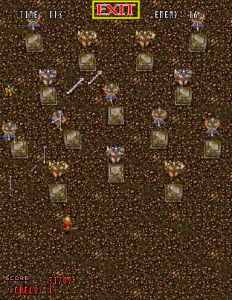
Sega: But isn’t playing the game alone a completely different experience than playing it with three players?
Yoshiki Ooka: Yes. This game isn’t meant to be a single-player game; it’s meant to be played with two or more people. In this game, there are times where you feel your partner screwed up and caused more enemies to appear and you have opportunities to steal someone else’s characters after they die. Your situation changes when other players are present. Gain Ground is a game you enjoy with two or more players.
Sega: Are you happy that the game is still going after all this time?
Yoshiki Ooka: Consoles and their software remain with players for a long time, but it’s the fate of arcade games that once they disappear from the stores, players might never see them again.
Yu Suzuki’s games have been revived on home consoles even until today, but those people who have never played Hang-On in the arcade just don’t know how scary it was to tilt the cabinet, to approach a curve, and to lift your butt five degrees upwards. This kind of element has been completely stripped from games nowadays. People who’ve actually played the game in the arcade have a different appreciation than those who’ve only heard the name or have only ever played the console port. As to how well you can convey this experience… that’s the question.
For the complete story of Gain Ground’s development, be sure to read The Sega Arcade Revolution: A History in 62 Games. The book chronicles Sega’s arcade legacy from 1966-2003 and is available in paperback and digital formats now from Amazon.

Recent Comments